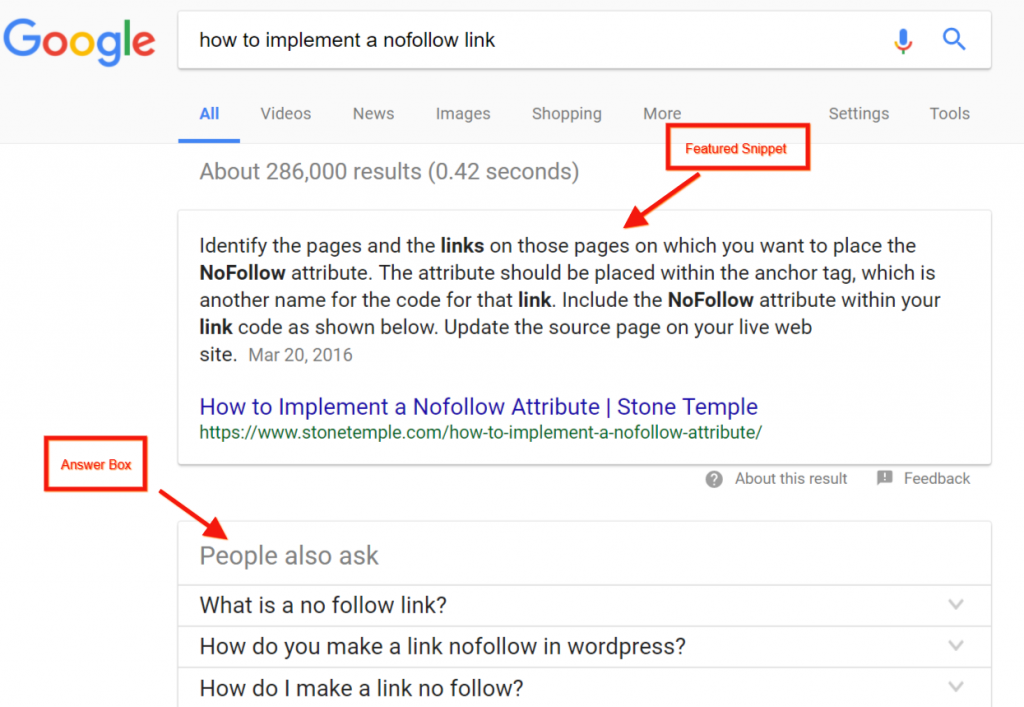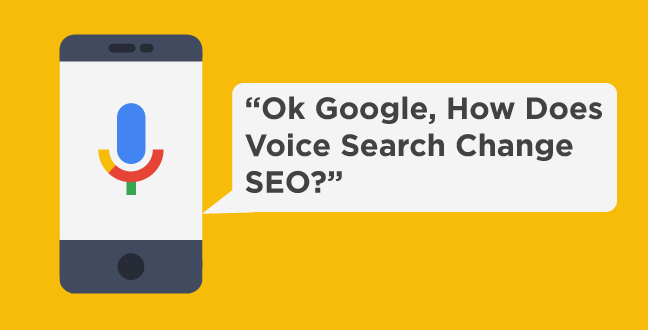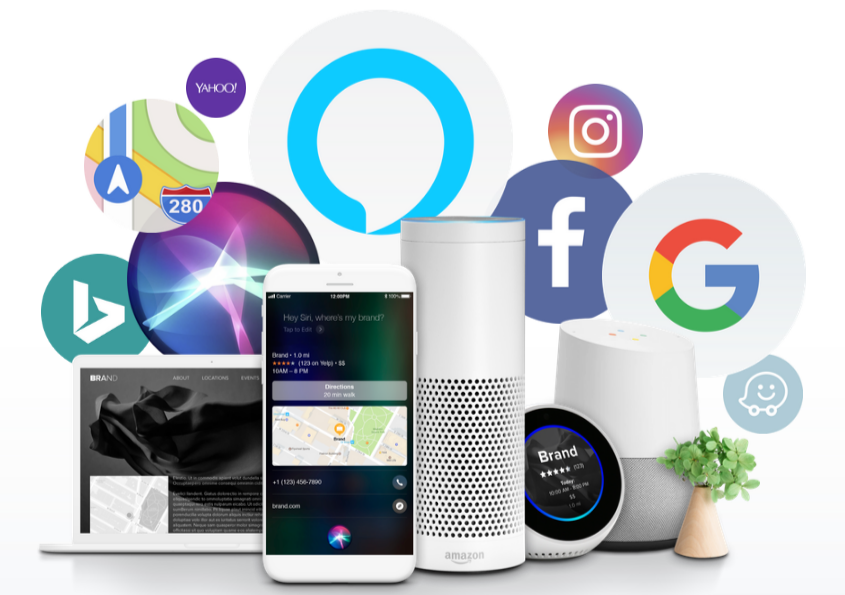![]() Approximately 5 billion searches are performed every day. Showing up first on Google has been one of the primary objectives for companies looking to be found online by potential customers. Just as Google rolls out new products, they have also changed their search product. There have been several changes in the way in which Google displays information — well beyond ads and blue links — in the past few years. They have adapted to rapidly changing consumer search behaviors.
Approximately 5 billion searches are performed every day. Showing up first on Google has been one of the primary objectives for companies looking to be found online by potential customers. Just as Google rolls out new products, they have also changed their search product. There have been several changes in the way in which Google displays information — well beyond ads and blue links — in the past few years. They have adapted to rapidly changing consumer search behaviors.
Google is constantly testing and developing new dynamic search interface layout features in order to better align with a searcher’s context and expectations on Search Engine Result Pages (SERPs). Of the 10,000 SERPs that the SEO software company Moz keeps track of, only three percent are purely organic results. Consumers have now grown accustomed to seeing rich content in the other 97 percent of SERPs which includes standard text listings, paid ads, local map results, images, videos, top news stories, knowledge graph panels, reviews, answer boxes, twitter carousel cards, product listing ads, featured snippets, and mobile first commerce.

Gone are the days when optimizing for search was all about trying to rank for the classic “10 blue organic links” on Google’s first page. Fast-forward to the more dynamic and visually appealing SERPs of today, which has had a huge impact on how businesses need to approach search marketing.
 Here is why.
Here is why.
The easiest way to explain it; there are a lot more choices and serp features being shown to users in the desktop experience compared to what it looked like even five years ago, which makes old school search engine optimization tactics a lot less effective. Google has since changed their desktop search layout to resemble their mobile search interface.
Search engine optimization has already become much more technical and advanced because search algorithms have become more advanced.
As mobile has surpassed desktop in search, new paid ad formats, local map packs, AMP pages, answer boxes and knowledge graph panel cards have all but replaced or a least decreased the ordered list of 10 blue organic links as the dominant form of search results. Last week Google announced three new search feature updates around featured snippets, knowledge panel information and suggestions for related topics.
Marketers and companies now need to consider how content is being evaluated and displayed by artificially intelligent search engine algorithms on a variety of devices so they can attract more clicks from the right search user at the right time.
From Google, Bing, Yahoo, or Youtube’s perspective, running a search engine is a multi-billion dollar business in which they are all vying for to monetize and secure their future relevance by trying to innovate and evolve what they do to align the needs and habits for the next generation of consumers.
As boomers age out of being the prime consumer target market for online advertising, millennials and the younger Generation Z are going inherit close to 30 trillion dollars from their Baby Boomer parent generation. This means advancements in AI, voice search, and mobile technology will push the elements beyond the “organic stack” and are becoming the market force that changes what it means to “rank” online.
So, what does it take to rank in these evolving AI infused search engines? Getting the number one spot on Google for many search queries doesn’t hold the same value we fondly remember from the past. As marketers, we need to be equally focused on converting the traffic we do get and making sure we provide an exceptional customer experience overall.
“There will always be a need for quality content. The content from marketers and researchers will need to provide more and more expertise in their answers — extending outward to include more than one angle of an issue.
Though the analytics will always be changing — to be certain — Google assures their place in the world because of our dependence on their ability to provide actual truth in the information that is valuable for businesses and personal usage.
Google’s overall exceptional customer experience must also include and rank with the ability for us to consume what we want to consume — on whatever device we want to consume it on.” Said John Rampton founder of Due.
1. Mobile search

Optimizing for mobile search (if not creating a dedicated mobile marketing strategy) is something you should’ve done by now, but if you haven’t, it needs to be done in 2019. No excuses. Fast, secure, mobile-optimized websites are the future. Your website should reflect the clear purpose of your company and have an easy-to-use interface. In fact, for many, a mobile device will represent the majority of content consumption, communication, and productivity (even purchase or investment decisions).
If you are an e-commerce business, optimizing your mobile product pages can increase your conversion rates to be closer to the desktop conversion experience. Mobile advertising is less competitive when it comes to media and ad buying. Additionally, integrating a common third-party payment system like Amazon or PayPal can streamline the payment process and increase conversion rates on mobile.
Marketers may need to keep tablets and mobile devices nearby for monitoring how content placement and design elements look on a non-desktop view. In addition, I expect a mobile site speed race in more competitive industries as load times on phones will be a crucial mobile search ranking factor in the years to come. If you’re wondering how fast is fast enough, take Google’s recommendation of 3 seconds or less.
To see how the speed of your website stacks up, you can take Google’s PageSpeed Insights.
Some ways you can improve page speed include:
- Investing in high-performance web hosting.
- Reducing http calls by merging CSS and JavaScript files, eliminating WordPress plugins and using sprites.
- Properly scaling and compressing images.
- Implementing server caching, browser caching and Gzip compression.
- Minifying CSS and JavaScript files.
Making your website secure is something your brand should finally consider doing. Google wants to serve secure pages to users and therefore prioritizes the HTTPS version over its HTTP counterpart. Sites that have not switched to HTTPS are now marked as “Not Secure” in Chrome browsers.
2. Develop rich location-specific knowledge for map app.

Local or map-based search queries has dramatically risen as people as more people search for specific products and services in map apps.
As a natural consequence of a more mobile-savvy consumer landscape, location specific searches are going to continue to increase. Personalized search results have taken over as search engines have begun to prioritize results based on device, interests, search history and physical location (results may vary between cities, and you may even see different Local Pack results within a matter of blocks).
According to Google’s data, almost 40 percent of people say they perform searches only on their smartphone device in the average day. Instead of returning a mess of blue links when people search maps and apps, search engines are returning direct answers for “children’s clothes near me” or “where’s the nearest pharmacy.” Try searching for a Samsung TV on your mobile device. The local stores that rise to the top are no coincidence.
As a result, winning in intelligent search environments is going to be increasingly about rich geo-specific information, such as hours, menus, location-specific images, services or delivery areas and more.
Another thing you can do is use Structured data markup — often called “schema markup” or “schema.org markup.” Schema markup is a microdata code format that you can use to help search engines parse and understand your website’s information more effectively. It can be added to your website’s code to provide search engines with more information about your business, like the products you sell, reviews you’ve collected, the services you offer and so on.
Only 31.3 percent of websites are using this markup — and most are only using the basics. You can make your local business stand out (and possibly rank higher than your competitors) if you add structured data markup to your site where appropriate.
Featured snippets (aka “position 0”) are selected search results that are featured on top of Google’s organic results below the ads in a box layout.
These search features have become so prominent that Google’s newest public search liaison Danny Sullivan just published a comprehensive guide on featured snippets on Google’s blog. In it, Google explains what featured snippets are, the various user interfaces and treatments you can get from these featured snippets and how they interact with the desktop, mobile and voice search results.

At the end of February 2018, Google updated it’s search results features with rolling out a new Multifaceted featured snippet that is targeting broad, nuanced search queries.
Featured snippets, for example, are one of the rewards of properly marked up and optimized content. This optimized content will consistently help visitors succinctly answer questions and help them quickly get the information they are requesting.
Conversational search, and the latent semantics that go into it, will seep into copywriting more. Search has become colloquial. As a marketer or business owner, it would be wise to start including questions and answers in your content and write in a more conversational, Q&A format. This will set up websites for voice search as it continues gaining popularity. Case studies indicate that a client’s website that won the feature snippet answer box for a search query saw the click-through rate (CTR) increase from two percent to eight percent with revenue from organic traffic increasing by 677 percent.
Yes, marketers have been talking about these features a lot, but I don’t think they fully realize that they will be far more important in the near future. By 2020, one estimate (from Andrew Ng, Chief Scientist at Baidu) says that 50 percent of all searches will be via voice or image. Data published by Eric Enge at Stone Temple suggest that two-thirds of people already use voice commands with their phone.
Furthermore, according to Strategy Analytics, “by 2020 75 percent of all Internet-connected devices will be devices other than a PC, smartphone, or tablet.” With that in mind, one can make the assumption that most devices in the future will be driven by voice interaction. While many of these may have companion screens, people will get used to interacting with them via voice and receiving their answers back via voice.
As Eric Enge says “the practical upshot of this is that you’ll be getting one single canonical answer. That imminent reality is the reason that Google and Bing are pushing featured snippets so aggressively.” They are striving to be able to determine the one best canonical answer, as in this new reality, it will be critical to the quality of their service, far more so that it is the case today (where the first reason being wrong is not a crisis if the second one is right).
That means it needs to be a huge priority for you, too. If most of the info searchers receive will be in a list of results containing only one answer, either you’re the source of that answer, or you’re not. And, yes, you want it to be you, and not your competitor.
A few tips for increasing your chances of winning a featured snippet position. There is no magic button or special markup which will guarantee your site gets featured. Of course, it’s a good idea to start with non-specific SEO best practices, simply because being featured is only possible when you rank high for the query.
You can use a tool called SEMrush or Serpstat that can show you what traffic is from featured snippets, etc. This article explores the 7 types of content that dominate most position zero snippets.
Here are 4 suggestions to increase your chances of showing up on a featured snippet:
- Compile a list of keywords in your niche that show snippets for which you don’t rank in the top 20.
- Create content specifically to answer questions. Provide in-depth answers.
- Create new content optimized for the format Google uses to display the snippet.
- Start with content that reaches people in the bottom of the funnel, like comparisons.. The volume is low, but the conversions can be high.
You may need to adjust your blogging style just a bit:
- Ask the question in your article (that may be a subheading).
- Immediately follow the question with a one-paragraph answer.
- Dive deep and go in-depth with your content — cover every question that could come up on the topic.
- Break down each step in the answer and use visual content to back it up, from videos to infographics and screenshots.
- Elaborate further in the article.
Google loves numbers, steps and lists. We’ve seen this again and again: More often than not, answer boxes will list the actual ingredients, number of steps, time to cook, year and city of birth, etc. As Google focuses on user intent and user experience, I suspect that featured snippets will continue to gain importance.
4. Encourage and respond to customer reviews.

As an example, if a user includes the term “best” with a keyword search that triggers local map results to be shown, some search engines will filter and only show results that are plus four stars. If the stars prove useful to satisfying users, it’s likely that the search engines will continue and expand upon this trend.
It’s important to create a marketing program that encourages feedback and reviews, as well as responding to any potentially negative reviews if your company wants to rank in future map queries. Also, a study conducted by Conversionxl found that having star rated reviews within an organic result listing contributed to a 35 percent increase in people choosing which link to click on. Take the free quiz from Trustpilot, find out how trusted you are online.
5. Structure your website and data for voice search.
Currently, more than 20 percent of queries are done thru voice search. Consumer behavior is shifting fast as voice search catches on across smartphone search and voice-enabled devices like Amazon Echo and Google Home. Google Home is leading the way in delivering answers to personalized voice queries because of the vast data sets it is able to access.
Most of the answers the device delivers are based on content marked up with the appropriate schema or written in a way that satisfies a quick answer or definition related to the search query.
Google and Amazon both ran very aggressively discounted holiday promotions last December on the Echo and Google Home — voice assisted devices. Flooding the market with voice search devices will encourage people to conduct voice searches as they find uses for their new toys.
The past few years have seen the rise of “context-aware” systems: technologies that can predict your intentions based on information about your environment. If you ask Google’s intelligent personal assistant, “How tall is that building?” it will use your phone’s GPS to see what buildings are near you and guess which building you are asking about.
Google is predicting that by 2020, more 50 percent of queries will come via image or voice. And with this there is often only one result spoken, leaving you with little choice but to structure and markup your content to remain relevant.
Also rather than optimizing for the top keywords, companies will need to focus on more complex natural language queries. For instance, instead of saying, “Where’s a storage facility near me?” they’ll say, “What’s the cheapest storage facility within a 10-minute drive?’” Which could trigger the expectation of getting pricing and other data?
Obviously, this new search technology is still in it’s the infancy stage. While voice search will seem quite natural in the mobile experience, search overall may still remain a very visual interaction. People will still crave images to help select and navigate as they purchase products or services.
6. Video marketing
Video Marketing: It’s no secret that video is one of the hottest digital marketing trends right now. Not only is YouTube the world’s second largest search engine, but there is also data to suggest that non-video-related content accounted for only 25 percent of all Internet traffic in 2017. Advertisers are now tapping into this power with live-streams. According to Facebook’s data, video maintains viewer engagement an average of three times longer as well as garner 10 times the amount of comments, in comparison with pre-recorded video.
When we talk about SEO, video is now a big part of the conversation, too. On-page media like video and images contribute to lower bounce rates, higher time on site and increased readability — all factors in organic rankings. As visual content becomes increasingly more popular on the internet, many brands will move toward making video their primary communication tool in 2019.

Watch for more and more companies to pick up on these trends in 2019, especially in conjunction with social media marketing. The leading social media platforms, such as Facebook, Instagram and Twitter, are heavily focused on a video-first strategy themselves. Eric Enge, of Stone Temple recapped an SMX expo and noted that: “Video may matter more in certain industry verticals, if you’re in the fitness business, videos make a lot of sense, but not so much for divorce or wine.”
7. Integrate and manage your digital knowledge across your entire enterprise. 
Until recently, it was reasonable that businesses would silo important business data in certain departments. Now, however, the world is rapidly changing and companies that want to stay ahead will be required to rethink this old practice. You now need:
- The insights that organic search provides into consumer research.
- The details paid search advertising provides on conversions.
- The feedback and intent signals social media experience provide across a wide range of locations.
These marketing channel programs at a minimum need to work in tandem together and feed all of this data into each other openly. Also, you will need to gather internal digital knowledge (products, people, hours, locations, inventory, holiday hours, etc.) and make sure that all the different marketing departments have instant access to it.
You will need to ensure all the channels and touchpoints along the consumer’s journey have the messaging aligned. One voice, one brand so to speak.
Finally, you need to ensure all programs and consumer touch-points lead with the same messages. One voice, one brand.
8. The future of search rankings: trust + rich user experiences.
Everything I have mentioned in this article so far speaks to the larger trend of a rich business data footprint becoming a bigger trust signal for search engines to rank phrases. The more elements about your business that can be curated and accurate, the richer the experience a search engine can provide to users, and the better you will rank in different search formats.
Utilizing new marketing and attribution tools that track success in this new intelligence search environment, across keywords and search formats, are increasingly important for measuring where you are successfully reaching consumers (and which areas are not performing as well).
In addition, 5G Wifi coverage for mobile devices will create and drive richer experiences as connectivity times decrease and data flows faster. For you as a marketer or business owner to be ready for this in the next year or so, you need to get serious about investing and owning your business data footprints all over the internet.
Managing your business data, and responding to things like reviews, will not just be a recommended thing in the future, it will be crucial.
Consumers are demanding more from brands. Business Intelligence analytics and customer experience tools are coming together to deliver on those expectations, leaving companies with little choice other than to wrangle in the data needed to answer consumer questions and queries, as needed.
And, we all can agree, that engaging with customers, whether it’s thru automation tools or by a human is rarely a bad thing for the health of a business.
9 Develop a PPC advertising strategy.
As we mentioned earlier that Google redesigned their desktop search layout to match their mobile search interface. With this change, they also removed the right rail of ads at the beginning of 2017, and added a fourth ad to be shown at the top; previously it was only three.

The top organic search result will no longer be visible above the fold on many desktop and tablet computers. If brands really want to get the most out of search, they’ll need to create an integrated organic and paid search strategy with focus on top rankings and paid ads to maintain visibility and be in front of their target audiences. According to recent predictions from eMarketer, states that “mobile advertising will drive 75 percent of all digital ad spend In 2018.”
Conclusion
The SERPs will continue to evolve as Google looks for new and innovative ways to make the desktop experience similar to the current mobile SERP and provide the most relevant results for end users. Five or six years ago running a business online used to be relatively simple. Today, search engines are gathering data from several devices and a consumer’s path to buying even more complex.
Understanding what to invest time and resources in now is critical for the success of tomorrow. The more results your business shows up in, or the more prominent those results are — the better off you will be. Keep an eye across the organic search results, Featured Snippets, the Local Map Pack, and the Knowledge Card. The more varied experiences you provide for your clients that saves them hassle and time — the higher your share of integrated search.
Clients and marketers will need to begin implementing multiple forms of digital marketing tactics, including paid search, social media marketing and local SEO in addition to their current SEO campaigns if they hope to dominate a given Google SERP.
Evaluating and gaining an understanding of your company’s “share of integrated search” is an important new component of SEO. Businesses that lag behind the metric will see that new agile-players in their fields — can and will — easily exploit the opportunity to step forward. Way too many companies have been slow in getting aligned with mobile search strategies. This shift could be even more impactful and could redefine business and brand as we know it. If you really want to dive deep into all these new changes, read Dr. Pete Meyer’s State of Search SlideShare called “Paradigm Shifts: Can SEO Survive Google?”
Now it’s time for your feedback! I want to know: what do you think are the most important areas of marketing to focus on to rank in 2019?












